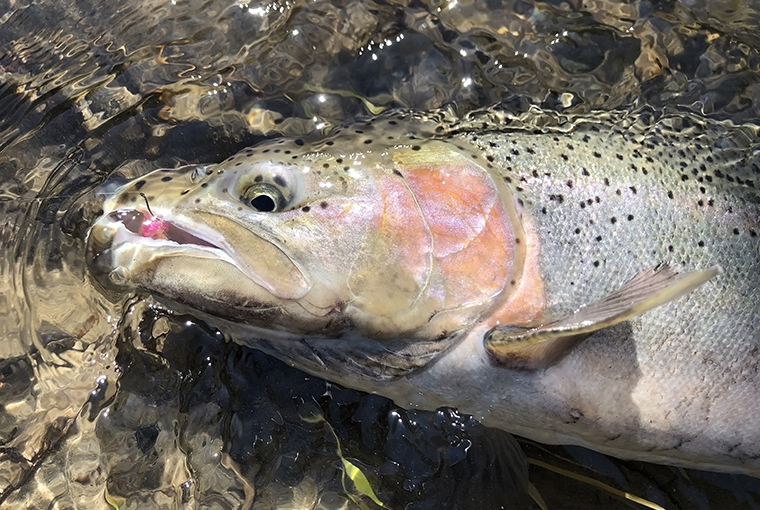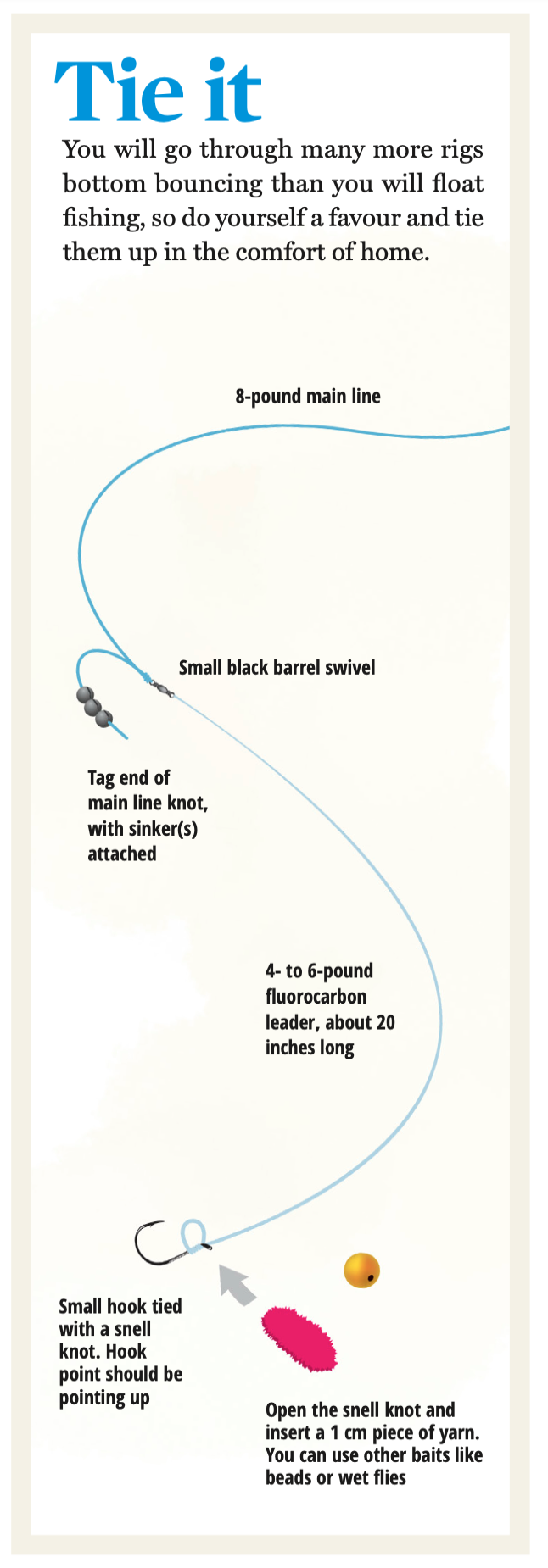
To truly feel the power of these fish, try bottom bouncing steelhead instead of using floats and long rods. Here’s how:
Few types of sport fishing are as dialed in as steelheading. Walleye anglers in three different boats fishing the same shoal will troll live bait, jig plastics, and cast crankbaits. Those targeting bass around weeds might drop shot edges, burn spinnerbaits, or dunk holes. Take a look, however, at any trout stream in Ontario from February to May and 99% of steelheaders are carrying a float rod and reel to present a roe imitation.
There is a good reason for this. Float fishing lets you present a bait at a very specific depth, at the perfect speed, precisely where you want it to be, while providing a visual cue that a fish has hit. Still, there is another proven but underused technique for hooking them.
A viable alternative
There was a time when plenty of steelhead were caught on shorter rods without floats. Bottom bouncing was the go-to technique before noodle rods took over. An experienced touch was required to distinguish the soft take of a steelhead as the rig — often presented with a nine-foot rod teamed with a multiplier fly reel — bounced over gravel, rocks, wood, and vegetation, and sensing that bite was the big payoff. There is nothing quite like feeling a steelhead bite and immediately setting the hook. It is game on, and because of the equipment used, you experience their speed and power more directly. For that reason and others, I still find myself turning to bottom-bouncing presentations every season for at least one trip.
Usually, bottom bouncing becomes a viable alternative to floats when conditions are most extreme. That means high water, low water, and deep water, but also days with heavy fishing pressure and high winds.
Rivers with shale or limestone bottoms are very well suited to drift fishing this way. Snags are fewer, and it is easier to detect the hit since the tap-tap-tap transmitted up the line is consistent. When that transmission is interrupted, it is likely because a fish has taken hold. A quality graphite rod is crucial to success. You should be able to feel your split shot scraping over rocks, not just bouncing over them.
Casting and positioning
To cast, just strip out several arm’s lengths of line and lob it upstream of where you think the fish are. It will tumble down and past you, swinging up from bottom at the end of the drift. Unlike a lot of float fishing, you don’t position yourself upstream from where you think the fish are. Instead, stand slightly downstream of them, or roughly parallel.
Once the rig is drifting, raise the rod tip to keep slack out of the line as it approaches you, and lower it as it goes by to maintain contact. Stealthy wading and awareness of your shadow lets you get very close to fish without spooking them.
The head of a pool
You can drift fish virtually anywhere you can float fish, but faster runs are best. A sweet spot to try is the deep, turbulent water at the head of a pool. Here, competing currents often create an unpredictable flow, making it challenging to get your bait down to the fish before the float pulls it downstream. When drift fishing, you can load up on split shot until the rig sinks quickly to where you want it to be. Typically, it will be in front of fish for only a few seconds before it is time to pull in line and cast it again. Rapid and repeated are the trademarks of this presentation.
One pool I fish has such a messed-up flow that I consistently see fish right at the bank, facing downstream, with their tails just beneath the surface over four feet of water. Those fish aren’t catchable, but the ones beneath at bottom where the current is not as strong, are. The surface current swirls powerfully backwards for only a few feet, submerging any float I have tried, and whisking away a bead or spawn bag before it can get anywhere close to bottom. Again, a quick drift, rapidly repeated is often enough to tempt a fish sitting in the calmer waters at the bottom.
The tailout
You can find success at the other end of the pool as well. Particularly at sundown, steelhead will effortlessly hang in place over the gravel of a classic tailout. They can be caught on a float, but since the water is barely deep enough to cover their backs, drifting is an easier option.
Position yourself out of their cone of vision — slightly upstream at the most, with parallel or downstream preferred — and toss into the deeper water of the pool. Since that will be slower water, you may need to give a twitch or two to get the rig bumping, but soon enough the accelerating water at the tailout will pull the bait toward fish.
Again, you are hoping for an interruption in the distinct tapping as the sinkers tumble across bottom. If you feel some contact and a bit of forgiving resistance, a steelhead has likely inhaled the yarn and lifted the sinkers off bottom.
Pocket water
Smaller back eddies, slicks in front of and behind boulders, and standing waves are also great spots to ditch the float. These compact spots hold fish, but don’t leave a lot of room for a float to do its thing. Brief, repeated drifts put your bait in front of fish more often and more easily than a float can.
Pocket water is often on fire when fishing pressure is at its heaviest. Opening day rainbows are quickly forced out of easily identified runs and pools into less obvious lies. If there is a lot of foam at the surface, you can fish right above fast water steelhead without spooking them.
Start by looking for those sections of river that no one else is fishing, and then identify things like small, calm slicks of water, two different currents converging in a v-shape, back eddies, or exposed boulders breaking up the flow and fish them.
In a small back eddy, shorten your leader and beef up the sinkers. Let the sinkers sit on bottom, while the yarn fly or bead circles the eddy on a perpetual spin cycle. Fish you didn’t think could jam themselves into that spot may be hiding under the foam.
Baits to drift

Yarn is awesome since it comes in so many colours and can be quickly changed. Orange/red, orange/chartreuse, and orange/pink are consistent colour combos for me. Yarn holds scents well, and can tangle like Velcro in a steelhead’s mouth giving you an extra split second to set the hook. Sponge works too, and any of the real or plastic and rubber single eggs can be effective. Of course, beads get the job done, and as the season progresses any wet fly pattern you would hang under a float can be drifted.
Drift and float fishing are a lot like trolling and downrigging. Downrigging is without a doubt a more versatile and precise way to fish than flat lining, but who has ever said, “it hit like a ton of bricks” when downrigging? Likewise, bottom bouncing gives you that extra jolt of fun when you feel the take. And because you are not using a rod that absorbs the fight, you experience more of the power the makes us love steelhead.
Tip: If fish are on the move, after you catch one, another will slide in to take its place. Sometimes it is better to camp out on a spot and let fish come to you.
Story time
Last year I had a good day of float-free fishing as a lazy wind blew down my home river on Lake Ontario. I call it “lazy” because it went right through you instead of around you. I began float fishing like usual, but despite my best efforts, the wind made accurate casting difficult even after I bumped up a float size or two. When I did place one in the right spot, the wind blew slack into the line and pulled the float away from where I wanted it, or worse, made me miss fish when the float dipped under.
I headed back to the truck and grabbed an old nine-weight fly rod with an equally ancient Martin 72 fly reel. It had the kind of drag and robust construction that a hooked steelhead respected. I rigged it up and hit the water.
I managed a couple fish that day, which does not qualify as a blue-ribbon day, but I’m convinced I only got them because I abandoned the floats.
Sinker options
Some 90% of the time, I will use a combination of 1 and 1 ⁄2-cm long egg sinkers. To fine tune the drift so the rig tumbles perfectly along bottom, add smaller split shot as needed. You want the rig to move at the same speed as the water on the river bottom. This is often dramatically different from what we see at the surface as rocks and debris create friction to slow the flow down below.
Regardless of what sinker style you use, just crimp them onto the tag end of the knot from the mainline to the swivel.
Pencil-style sinker material also makes a good drift fishing option. It gets down quickly and you can fish it off a three-way swivel. Secure a length of surgical tubing to the bottom eye of a three-way and jam the pencil lead into it. This transmits bottom very well, though it can be snaggy. Typically, the sinker pulls free of the tubing when snagged, so re-rigging is quick.
For the ultimate is snag-free drifts, go with a “slinkie.” Nothing more than various lengths of heat-sealed parachute cord stuffed with split shot, these sinkers rarely get fouled, but don’t telegraph what’s happening along bottom like the first two options.
Snag solutions
Snags are inevitable. Nine times out of 10 when snagged, the sinkers are lodged between rocks and a steady pull will release them. Once your line is free, just crimp on a couple more sinkers instead of re-tying the whole rig.
Published in Ontario OUT of DOORS’ Fishing Annual 2024
For more fishing stories, click here
Click here for more outdoors news






Leave A Comment